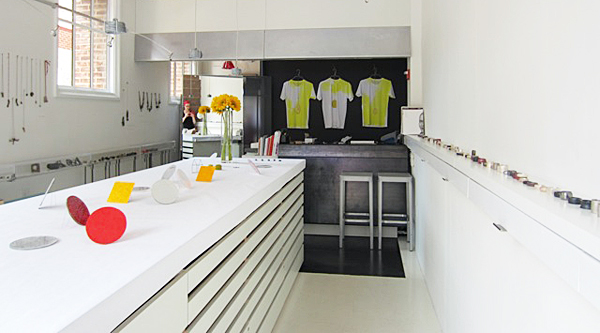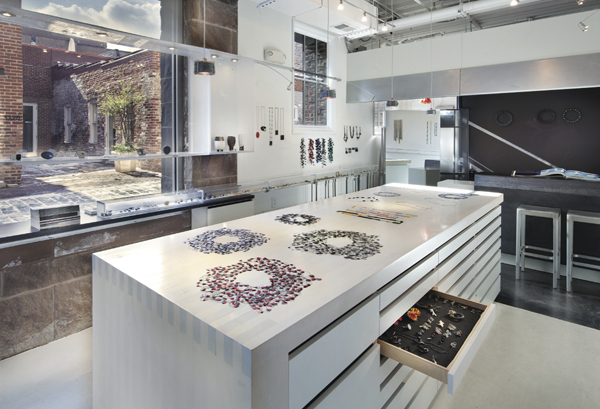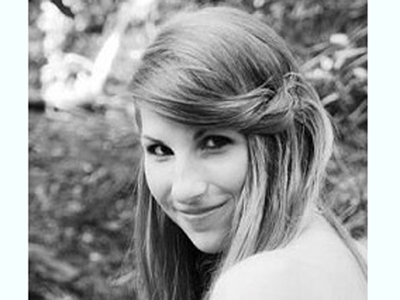
Missy Graff: Can you please explain how your gallery came to be located in Washington, DC, and how you chose your particular location in that city?
Ellen Reiben: Jewelers’Werk Galerie started out as V.O. Galerie in 1984. It was founded by Joke von Ommen, a Dutch jeweler who was married to an American violinist, and they lived outside of Washington, DC. She was killed in a car accident in 1988, and I took over the gallery in November of that year. For some legal reasons, the gallery name had to be changed. That was when the name Jewelers’Werk was born. At the time of Joke’s death, I actually had my work in the gallery. Between 1984 and 2007, the gallery was located at 2000 Pennsylvania Avenue, close to the World Bank and the White House. In 2007, I moved the gallery to its present location on a lovely alley in Georgetown that is a bit off the beaten path but still a popular spot once people discover it. The alley shops all focus on design.

Ellen Reiben: I have been involved in artists’ jewelry since 1970, when I took my first class in jewelry at the University of Wisconsin in Madison. In 1981, I got my MFA in the field from the Rochester Institute of Technology, School for American Craftsmen, in Rochester, New York, under Gary Griffin. It has always been very helpful to me to have been on the artists’ side of this business of directing a gallery, because I really do know how it is to be the artist. It is also a real plus to have such a long history in this field. It means I know what I am looking at, and I know the history of the field. I know what is new, what is derivative, and where things come from. This informed intuition and historical perspective is important for the credibility of my gallery, and I rely on it often.
Your gallery exhibits work from a large number of European artists. What are the main differences you see between the work of American and European jewelers, if any?
Ellen Reiben: When I took over the gallery, I continued with the original owner’s focus, which was to bring European artists’ jewelry to this country. I felt it was important to honor that original raison d’être, and so I have been representing International artist jewelers for 25 years.
Many jewelers are shifting toward using nontraditional materials and incorporating found objects into their work. How do you explain the value of this type of work to those who are not familiar with contemporary art jewelry?

Ellen Reiben: When I was working on my master’s degree, I mainly used plastics—epoxy resin, acrylic, and some metal—and in the 1980s, much of the “new jewelry” was from nonprecious materials, so this isn’t exactly a new thing. Found objects have also been part of this new jewelry for many decades. When I am showing a client a piece that is comprised of nonprecious materials, I talk about how the value of this jewelry is similar to the value of a painting. A painting is not valuable because of the paint and canvas, but rather because of the artist’s perspective and concept and how it is portrayed, developed, and expressed. An art piece, whether jewelry or sculpture or painting, should have an effect on how you perceive. It should provoke you to see things in a new light. If the artist has a strong “vocabulary” in the work and an original concept and approach, it will impact its audience and enlighten the viewer. Sometimes good work enrages, too. These responses are all positive outcomes of significant and powerful work.

Ellen Reiben: I do see a change in the collector. The collectors I have worked with have gradually broadened their horizons and slowly come to appreciate pieces now they might have run from before! It is a matter of comfort, and gradually that comfort level evolves. The sophistication level of collectors has grown very fast in the last few years; more and more they are exposed to international work, which can be more challenging.
What is your relationship with your collectors like? Do you develop friendships? Do you take them out to dinner a lot?
Ellen Reiben: I do enjoy my relationships with collectors. I think this job is all about relationships and trust. And yes, I do develop friendships. I don’t court them with lots of dinners (financially difficult for me), but there is a bond created and a social relationship often develops.
What are the three most important things you look for in an artist’s work?
Ellen Reiben: I look for originality (a fresh viewpoint and new way to express it), focus (not easily tempted to veer off or shift attitude), and mastery of materials (including using materials that fully support a concept). I personally need an artist to be easy to work with and trustworthy to complete work on time, etc.
What advice do you have for emerging artists?
Ellen Reiben: Emerging artists just need to keep working. It is all about the work. I don’t like to see a young artist spending most of his or her time self-promoting, as if this is the key to success. It is the work that counts. And it takes many years and perseverance to get work to a profound level, if it happens at all.
Thank you.




